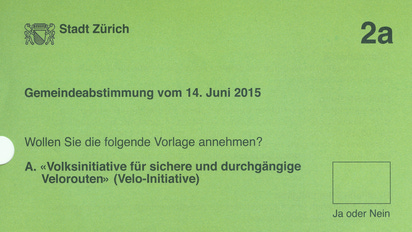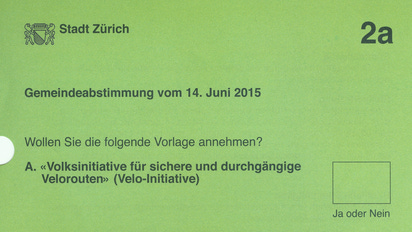Referendum Mechanics in a Marketplace of Ideas
In a referendum, people vote either for or against the proposal and that's it. Right? Wrong!
One can definitely make referendums more complex by mixing in unrelated stuff, unnecessary restrictions, and complexities. But that's not the case with Swiss referendums. Quite the contrary, they seem to be designed for simplicity:
First: There is no quorum. Even if the turnout is low, the referendum is valid. If three people cast their votes in a national ballot and two of them vote yes, the proposal is accepted. It is then written into the constitution, so even the parliament cannot overrule it. No quorum means no strategic voting or, more precisely, no strategic withholding of votes to sabotage the referendum by making it invalid due to not meeting the quorum, as often happens elsewhere.
Second: The referendum process takes many years, often five or more, so it can't be used for short-term, tribal politics, like calling for premature elections. By the time the referendum reaches voters, five or six years after its initiation, other people are already in power, and the original reason for the referendum has long since become irrelevant. Hot-button issues of yesteryear are already blissfully forgotten.
Third: We know that defaults matter. If the referendum question is worded differently — when yes and no votes switch their meanings — it could lead to a different voting outcome. But in Switzerland, referendum questions are always worded the same way: It's a proposal to change the constitution. "Yes" always means a vote for change, while "No" always means to keep the status quo. And if the history of past referendums teaches us anything, it is that the default option is always "No." Only a few referendums in their 150-year history have been successful. If people don't understand or don't care about the proposal, they vote to keep the status quo by default.
Given all the above, why am I suggesting that the referendums can get complex? Read on and discover the fascinating world of referendum politics!
Imagine that the initiators of the referendum demand lowering a tax by 4%. (And yes, in Switzerland, any changes to taxes must be approved in a referendum.)
The government doesn't want to change the tax. If they did, they would have already put it on the ballot. So, the government commissions a survey, which reveals that 60% of voters are going to vote for the proposal. What can they do to fight it?
Well, of course! They can launch a counterproposal. They can propose that the tax should be lowered by only 2%.
Now, voters can choose to either keep the tax at the current level, lower it by 2%, or lower it by 4%. If they can vote for only one of the two latter options, the counterproposal does more than just deliver more choice to the voter. It also splits the voter base.
If originally 40% of voters were about to vote for keeping the current tax rate and 60% for lowering it, the anti-tax people would be clear winners. However, introduction of the counterproposal dramatically changes the landscape. Now 40% vote for keeping the tax at its current level, just like before, but 25% now vote for lowering it by 2% and 35% for lowering it by 4%. Pro-taxers suddenly and miraculously win the referendum!
Eventually, it became obvious that the system was not working as intended and could be easily manipulated. So since 1987, voters can vote for both the original proposal and the counterproposal. (So called “double yes“.) If they do so, they can also indicate which option they prefer in case both proposals pass. The splitting of the voter base, as described above, does not happen.
Okay, fair enough, you say. But it cannot get much more complex than that, can it?
Well, it can.
When a popular initiative for mandatory disclosure of donations to political parties was launched in 2016, it quickly gained widespread support. At the time there was no requirement to disclose the donations, which meant nobody was sure about which party is financed by whom. Additionally, the Swiss state does not finance political parties at all, so the donations do really matter. The surveys showed that around 80% of the voters were in favor of the measure. And unsurprisingly, most political parties were against it.
Given that there was no chance of the proposal being rejected in the referendum, the government wasted no time and acted immediately.
They enacted a law requiring disclosure of donations to political parties above 15,000 francs and to campaigns above 50,000 francs - as opposed to the 10,000 franc threshold proposed by the popular initiative.
The mechanism used here is called "indirect counterproposal". The idea is that if you can't outright defeat a proposal, you can change the status quo to make it more acceptable to voters. Opponents of the original proposition can no longer maintain the old status quo. They must, like it or not, align with supporters of the moderate version of the proposal. Both groups will then vote against the more extreme version of the proposal, with the hope of rejecting it at the ballot box.
Can it get even more complex?
So far, we have assumed that those in favor of a proposal are an amorphous mass of voters with no agency beyond the ability to cast a vote.
But that's not the case. There is a so-called "referendum committee," a group of people driving the popular initiative. This committee has one important tool at its disposal: The ability to withdraw the proposal.
Being able to decide whether the referendum takes place at all gives them a natural place at the negotiation table, along with a strong negotiating position. They can negotiate with the government and ask for concessions in exchange for canceling the referendum.
This is exactly what happened in the referendum about donations to political parties. When the government enacted the indirect counterproposal, the referendum committee withdrew the original proposal.
But there's more.
So far we've assumed an adversarial relationship between the government and the referendum committee. However, that's not necessarily the case. Switzerland practices consensual democracy, rater than the better known competitive democracy. The goal is to find the compromise not by fighting each other, but rather by bringing all the stakeholders to the table and trying to find a common ground. While this distinction is a spectrum, Switzerland leans as far toward the consensual side as it gets.
Therefore, while the referendum committee and the government may have different ideas about how to solve the problem, they do share the common goal of making Switzerland a better country. In this sense, they benefit from each other. It may be hard for non-Swiss minds to comprehend, but think of it this way: The government benefits from the committee because it points out problems that the government may not even be aware of. The referendum committee, on the other hand, benefits from the government because the latter has more experience with drafting laws and implementing policies, better access to experts, more funding, and so on.
For example, in the popular initiative against urban sprawl, the government pointed out that the text, as worded by the committee, would mean that chicken farms could only be built inside industrial zones. This was definitely not the intention of the initiators. It's therefore not particularly surprising that the committee often withdraws the proposal and supports the more thoroughly thought-out governmental counterproposal.
As already said, out of several hundred popular initiatives in past century and half, only around twenty or so were successful. And that's not a bug, that's a feature. I would even say that in the ideal case no initiative would ever be successful. Instead, the launching of the initiative should lead to negotiations, deliberation and eventually to the solution of the problem by more standard means. The referendum acts only as a threat, as a whip, as an incentive to take negotiations seriously and not let them fizzle out.
If you asked me how to improve the current Swiss political system, I would propose going even further in this direction. The role of the popular initiative as a mere threat and incentive should be explicitly recognized and each successful referendum should be treated as a failure of the system. After each successful referendum, everyone involved should ask: Why has it gone this far? Why have we failed to reach a negotiated solution? What went wrong? And how can we prevent it from happening again? Both the government and the referendum committee should write a postmortem. Or better yet, they should write a postmortem together (adversarial collaboration!). In this document, they should analyze the failure to rach a compromise and propose measures to avoid similar failures in the future. Such proposals should eventually be incorporated into the referendum process.
All in all, the system of referendums, as practiced in Switzerland, is a unique implementation of the idea of a marketplace of ideas. This system is crafted — not by fiat, but in a fuzzy, evolutionary way — to allow new ideas to enter the marketplace. It’s done by allowing anyone to launch a popular initiative. It brings these ideas to the public stage, as any upcoming referendum is extensively discussed in the press and on TV. It filters out bad ideas, as initiatives with little public support tend to receive little attention. And the mechanics of the referendum, as described in this article, are designed to bring all stakeholders to the negotiating table, giving everyone a strong incentive to reach a well-thought-out negotiated compromise.




